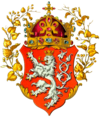Charles IV, Holy Roman Emperor
| Charles IV | |
|---|---|
 Charles IV in the Votive Panel of Jan Očko of Vlašim | |
| Holy Roman Emperor King of Italy | |
| Reign | 1355 – 29 November 1378 |
| Coronation | |
| Predecessor | King of Bohemia |
| Reign | 26 August 1346 – 29 November 1378 |
| Coronation | 2 September 1347, Prague |
| Predecessor | John |
| Successor | Wenceslaus IV |
| Born | 14 May 1316 Prague, Kingdom of Bohemia |
| Died | 29 November 1378 (aged 62) Prague, Kingdom of Bohemia |
| Burial | , Prague |
| Spouses | |
| Issue | |
Elisabeth of Bohemia | |

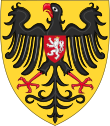
Charles IV (
He was the eldest son and heir of
On
The Golden Bull of 1356 marked a structural change in the politics of the Holy Roman Empire. Several aspects of his legacy remain a contentious matter though. The image of Charles as a wise, pious, peace-loving king (partly constructed by Charles himself) has proved influential until this day, supported by several artistic or scholarly projects produced during Charles's reign or afterwards.
Life
Birth and childhood
Charles was born to
Charles received French education and was literate and fluent in five languages:
Italy and Moravia
In 1331, he gained some experience of warfare in Italy with his father. At the beginning of 1333, Charles went to Lucca (Tuscany) to consolidate his rule there. In an effort to defend the city, Charles founded the nearby fortress and the town of Montecarlo (Charles' Mountain).[8]
From 1333, he administered the
King of the Romans
On 11 July 1346, in consequence of an alliance between his father and

Charles IV was in a very weak position in Germany. Owing to the terms of his election, he was derisively referred to as a "Priests' King" (Pfaffenkönig). Many bishops and nearly all of the
Civil war in Germany was prevented, however, when Louis IV died on 11 October 1347, after suffering a stroke during a bear hunt. In January 1349, partisans from the House of Wittelsbach attempted to secure the election of Günther von Schwarzburg as king, but he attracted few supporters and was defeated by Charles at the siege of Eltville in May. Thereafter, Charles faced no direct threat to his claim to the Imperial throne.
Charles initially worked to secure his power base.

Having made good use of the difficulties of his opponents, Charles was again elected in
In 1350, the king was visited at Prague by the Roman tribune Cola di Rienzo, who urged him to go to Italy, where the poet Petrarch and the citizens of Florence also implored his presence.[10] Turning a deaf ear to these entreaties, Charles kept Cola in prison for a year, and then handed him as a prisoner to Clement at Avignon.[9]
Outside Prague, Charles attempted to expand the Bohemian crown lands, using his imperial authority to acquire fiefs in Silesia, the Upper Palatinate, and Franconia. The latter regions comprised "New Bohemia", a string of possessions intended to link Bohemia with the Luxemburg territories in the Rhineland. The Bohemian estates, however, were not willing to support Charles in these ventures. When Charles sought to codify Bohemian law in the Maiestas Carolina of 1355, he met with sharp resistance. After that point, Charles found it expedient to scale back his efforts at centralization.
Holy Roman Emperor
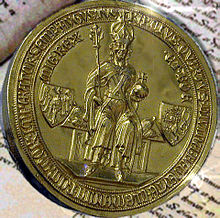
In 1354, Charles crossed the
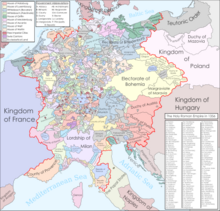
Having given

His second journey to Italy took place in 1368 when he had a meeting with Pope Urban V at Viterbo, was besieged in his palace at Siena, and left the country before the end of 1369. During his later years, the emperor took little part in German affairs beyond securing the election of his son Wenceslaus as king of the Romans in 1376, and negotiating a peace between the Swabian League of Cities and some nobles in 1378. After dividing his lands between his three sons and his nephews,[1] he died in November 1378 at Prague, where he was buried, and where a statue was erected to his memory in 1848.[9]
Charles IV suffered from gout (metabolic arthritis), a painful disease quite common in that time.
Legacy
Evaluation
The reign of Charles IV was characterized by a transformation in the nature of the Empire and is remembered as the Golden Age of Bohemia. He promulgated the Golden Bull of 1356 whereby the succession to the imperial title was laid down, which held for the next four centuries.
He also organized the states of the empire into peace-keeping
He assured his dominance over the eastern borders of the Empire through succession treaties with the
In 2005 Charles IV ranked the first in the TV show Největší Čech, the Czech spin-off of the BBC Greatest Britons show.
Patronage of culture and the arts
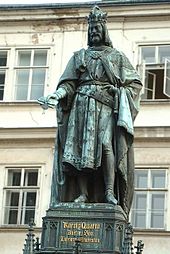
Charles also had strong ties to
Charles's imperial policy was focused on the dynastic sphere and abandoned the lofty ideal of the Empire as a universal monarchy of Christendom. In 1353, he granted the Duchy of Luxembourg to his half-brother, Wenceslaus. He concentrated his energies chiefly on the economic and intellectual development of Bohemia, where he founded the university in 1348 and encouraged the early humanists. He corresponded with Petrarch and invited him to visit the royal residence in Prague, whilst the Italian hoped – to no avail – to see Charles move his residence to Rome and reawaken tradition of the Roman Empire.
Charles's sister
Castles
Castles built or established by Charles IV:[13]
- Czech Crown Jewelswere also kept there)
- Kašperk (Karlsberg), 1356 in Kašperské Hory in Plzeň Region
- Lauf (Wenzelsburg) – built on the way connecting Prague and Nuremberg in Bohemian Palatinate, inside survived 112 coats of arms of the Bohemian Kingdom
- Montecarlo in Italy
- Radyně (Karlskrone) – around 1360 in Plzeň Region
- Hrádek u Purkarce (Karlshaus) – around 1357
- Tepenec (Twingenberg, Karlsburg) in Jívová in Olomouc Region
- Karlsfried
Places named after Charles IV
- Czech Republic
- Karlovy Vary, a spa city
- Karlštejn, a town beyond the eponymous castle
- Charles Bridge (Karlův most), Prague
- Charles University (Univerzita Karlova), Prague
- Multiple squares – Charles Square (Karlovo náměstí) in Prague and others, for example in Brno, Kolín, Mělník etc.
- Multiple streets
- Italy
- Montecarlo (Charles's Mountain), a municipality
Other

- The 100-Czech koruna banknote
- 16951 Carolus Quartus, an asteroid
Family
Genealogy
| Henry VII (Henry of Luxembourg) c. 1273 – 24 August 1313 King of the Romans King of Italy Holy Roman Emperor | Margaret of Brabant 4 October 1276 – 14 December 1311 | Judith of Habsburg 13 March 1271 – 18 June 1297 | Wenceslaus II 27 September 1271 – 21 June 1305 King of Bohemia King of Poland | ||||||||||||||||||||||||||||||||||||||||||||||||||
Elisabeth of Bohemia 20 January 1292 – 28 September 1330 | Wenceslaus III 1289–1306 King of Hungary King of Croatia King of Bohemia King of Poland | ||||||||||||||||||||||||||||||||||||||||||||||||||||
| m1. 15 May 1323 | m2. March 1349 | m3. 27 May 1353 | m4. 21 May 1363 | ||||||||||||||||||||||||||||||||||||||||||||||||||
| Blanche of Valois 1316 – 1 August 1348 | Anne of Bavaria 26 September 1329 – 2 February 1353 | Charles IV (Wenceslaus/Charles of Luxembourg) 14 May 1316 – 29 November 1378 King of Bohemia King of the Romans King of Italy Holy Roman Emperor | Anna von Schweidnitz 1339 – 11 July 1362 | Elizabeth of Pomerania c. 1347 – 14 February 1393 | |||||||||||||||||||||||||||||||||||||||||||||||||
| son born 1334 | Catherine of Bohemia 1342–1395 | Wenceslas 1350–1351 | |||||||||||||||||||||||||||||||||||||||||||||||||||
| Elisabeth of Bohemia 1358–1373 | Wenceslaus IV (Wenceslaus of Luxembourg) 1361–1419 King of Germany King of Bohemia | son 1362 | |||||||||||||||||||||||||||||||||||||||||||||||||||
| Richard II 1367–1400 King of England | Anne of Bohemia 1366–1394 | Sigismund (Sigismund of Luxembourg) 1368–1437 King of Bohemia Holy Roman Emperor King of Hungary | John of Görlitz 1370–1396 | Charles 1372–1373 | Margaret of Bohemia 1373–1410 | Henry 1377–1378 | |||||||||||||||||||||||||||||||||||||||||||||||
Marriages and children
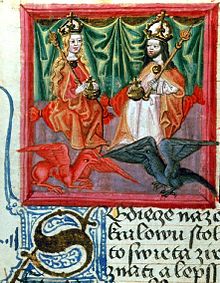
Charles was married four times. His first wife was
- son (born 1334), died young.
- Margaret of Bohemia, Queen of Hungary (1335–1349); married King Louis I of Hungary.[14]
- Catherine of Bohemia (1342–1395); married Rudolf IV, Duke of Austria[15] and Otto V, Duke of Bavaria and Elector of Brandenburg.
He secondly married
- Wenceslaus (1350–1351).
His third wife was
- Elisabeth of Bohemia (19 April 1358 – 4 September 1373); married Albert III, Duke of Austria at the very young age of 8 and died at the age of 15, they had no children.[5]
- Wenceslaus IV of Bohemia (1361–1419);[5] later elected King of Germany (formally King of the Romans) and on his father's death, became King of Bohemia (as Wenceslaus IV) and Emperor-elect of the Holy Roman Empire; married firstly to Joanna of Bavaria in 1370 and secondly to Sophia of Bavaria in 1389.
- son (born and died 11 July 1362).
His fourth wife was
- Anne of Bohemia, Queen of England (1366–1394); married King Richard II of England.[16]
- Herman II, Count of Celje, in 1405/1408.
- Duchess of Luxembourg.
- Charles (13 March 1372 – 24 July 1373).
- Margaret of Bohemia, Burgravine of Nuremberg (1373–1410); married John III, Burgrave of Nuremberg.[16]
- Henry (1377–1378).
Charles had one illegitimate son, William, born in 1362 to an unknown woman. He was raised in Brabant and seems to have joined his father at the time of the latter's trip to France in 1377. He was acknowledged by his father, who sought a
References
- ^ a b Karl IV. In: Hans Herzfeld [de] (1960): Geschichte in Gestalten (History in figures), vol. 2: F–K. Das Fischer Lexikon [de] 38, Frankfurt 1963, p. 294
- ISBN 0-521-43155-7.
- ISBN 978-0313363054.
- ISBN 978-0817944926.
- ^ a b c d e Boehm & Fajt 2005, p. xvi.
- ^ "Charles IV – the greatest Czech". Prague City Tourism Prague City Tourism. Retrieved 19 April 2020.
- ISBN 9781317093978.
- ^ Montecarlo
- ^ a b c d e f g h i j One or more of the preceding sentences incorporates text from a publication now in the public domain: Chisholm, Hugh, ed. (1911). "Charles IV. (Roman Emperor)". Encyclopædia Britannica. Vol. 5 (11th ed.). Cambridge University Press. pp. 898–899.
- Francesco Petrarca Epistolae familiaresX.1, XII.1, XVIII.1; See also: E.H. Wilkins Life of Petrarch (Chicago, 1961) 97, 112, 134 resp.
- ^ František Palacký. Dějiny národu českého v Čechách i v Moravě, books VIII and IX
- Francesco Petrarca, Epistolae familiaresXIX.12; see also E. H. Wilkins, Life of Petrarch (Chicago, 1961), p. 147
- ^ Karel IV. – český král
- ^ Dvornik 1962, p. 52.
- ^ Jaschke 1997, p. 102.
- ^ a b c d e Boehm & Fajt 2005, p. xvii.
- ^ Ondřej Schmidtm John of Moravia between the Czech Lands and the Patriarchate of Aquileia (ca. 1345–1394) (Brill, 2019), p. 31.
Bibliography
- Boehm, Barbara Drake; Fajt, Jiri, eds. (2005). Prague: The Crown of Bohemia, 1347–1437. Yale University Press.[ISBN missing]
- Dvornik, Francis (1962). The Slavs in European History and Civilization. Rutgers University Press.
- Jaschke, Karl-Ulrich (1997). "From Famous Empresses to Unspectacular Queens". In Duggan, Anne J. (ed.). Queens and Queenship in Medieval Europe. The Boydell Press.[ISBN missing]
Further reading
- Charles IV (autobiography), edited by Balázs Nagy, Frank Schaer: Autobiography of Emperor Charles IV; And, His Legend of St. Wenceslas: Karoli IV Imperatoris Romanorum Vita Ab Eo Ipso Conscripta; Et, Hystoria Nova de Sancto Wenceslao Martyre, Published by Central European University Press, 2001, ISBN 978-9639116320, 259 pages, books.google.com
- Boehm, Barbara Drake (2005). Prague : the Crown of Bohemia, 1347–1437. New York: The Metropolitan Museum of Art. ISBN 1588391612.
External links
- Literature by and about Karl IV. in the German National Library catalogue
- Works by and about Charles IV, Holy Roman Emperor in the Deutsche Digitale Bibliothek (German Digital Library)
- Entry in the Residenzen-Kommission
- Regesta Imperii
- Publications on Charles IV. in the OPAC of the Regesta Imperii
- 'Constitutiones et acta publica imperatorum et regum 1357–1378' – digital pre-publication of documents by Charles IV by the MGH
- "Carolus IV". Repertorium "Historical Sources of the German Middle Ages" (Geschichtsquellen des deutschen Mittelalters).
- Aleksandra Filipek-Misiak, Karol IV Luksemburski jako ideał władcy w Catalogus abbatum Saganensium Ludolfa z Żagania, In: Historie – Otázky – Problémy, 7 (2015), z. 1, pp. 76–89
- Lewis E 64 Golden Bull of Charles IV at OPenn


